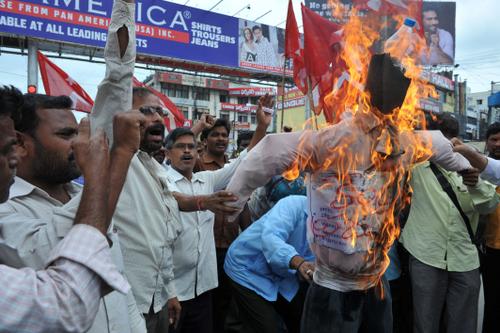India: Spike in inflation shatters hopes of rate cut
Members of the Communist Party of India, Marxists(CPI-M) burn an effigy of United Progressive Alliance (UPA) government during a protest against petrol price rises in Hyderabad on September 16, 2011. Rising oil costs have contributed to a spike in inflation that is becoming a major headache for India as the rupee plunges against the dollar.
The prime minister's moves to hike prices for petrol and diesel fuel, thus reducing the government's subsidy bill and moving closer to balancing the budget, resulted in a spike in inflation that has put paid to industry's hopes for an interest rate cut.
Inflation rose to a 10-month high 7.8 percent in August, thanks mainly to the fuel price hike, Reuters reported Monday.
"The Reserve Bank of India (RBI) has held its policy rate at 8 percent since April, even though economic growth is at its weakest in three years, saying stubbornly high inflation prevents it from cutting borrowing costs. Inflation is well above the central bank's comfort level of 4-5 percent," the agency said.
Though India's economic growth has slowed dramatically — with some agencies predicting it will drop below 5 percent in the next fiscal year — the country's impoverished population makes it very sensitive to inflation, since high prices hit the poor first and the poor are most easily led to the polling booth.
Unfortunately, however, most experts estimate that India needs economic growth of 10 percent just to keep up with increases in the number of its working-age citizens with new jobs, so Manmohan Singh is caught between the devil and deep blue sea.
The article you just read is free because dedicated readers and listeners like you chose to support our nonprofit newsroom. Our team works tirelessly to ensure you hear the latest in international, human-centered reporting every weekday. But our work would not be possible without you. We need your help.
Make a gift today to help us reach our $25,000 goal and keep The World going strong. Every gift will get us one step closer.
